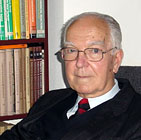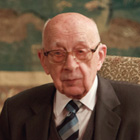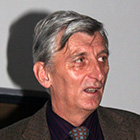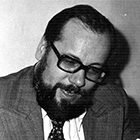History
21 significant dates in the 50 year history of the Jerzy Haber Institute of Catalysis and Surface Chemistry Polish Academy of Sciences
- 1968 Replacing earlier Laboratory of Physical Chemistry of Surface Phenomena headed by professor Bogdan Kamieński, part of the Institute of Physical Chemistry in Warsaw, the Presidium of the Polish Academy of Sciences establishes Research Laboratories of Catalysis and Surface Chemistry as an independent unit of the Academy. Jerzy Haber, an associate professor of the Academy of Mines and Metallurgy in Krakow, becomes head of the Laboratories. In the same year, he becomes full professor, opening a long train of professors in the organisation. Jerzy Haber conceptualized the Laboratories as a platform of sharing ideas and research in the entire field of physical chemistry of interfaces: gas-solid, gas-liquid and liquid-solid. The Laboratories begin with modest workforce of 28 employees (and only five working in the area of catalysis) and a few rooms made available by the Institute of Chemistry of the Jagiellonian University and the Academy of Mines and Metallurgy.
- 1971 First paper in by Laboratory’s staff on the preparation of bismuth molybdates is published.
- 1972 Construction of a one-storey pavilion in Krakow-Chełm begins, the first provisional seat of the Laboratories in which they function until the end of the 1990ies.
- 1973 An outline of the two-centre olefin oxidation mechanism is published in again, the key achievement in the area of heterogeneous catalysis during first five years of the research activity of the new laboratories.
- 1974 First X-ray photoelectron spectrometer is acquired – a symbol of beginnings of the surface physics in the organisation.
- 1975 Theoretical research starts in collaboration with the Chair of Theoretical Chemistry of the Jagiellonian University. First paper is published in describing the charge distribution and electronic configuration of Π-allyl complexes with metal ions in oxide structures.
- 1978 The Presidium of the Polish Academy of Science establishes its Institute of Catalysis and Surface Chemistry by transforming the existing Research Laboratories. The newly established Institute has the second full professor Andrzej Pomianowski, leading research in physical chemistry of processes at liquid-gas and liquid-solid interfaces.
- 1979 Professors Jerzy Haber and Adam Bielański publish in . The paper has become the most quoted publication in the entire history of the Institute.
- 1991 The Institute is granted rights to confer the degree of doctor in chemical sciences. The Institute confers the first doctoral degree in its history in 1994 to Renata Tokarz based on her dissertation
- 1998–1999 Celebration of Institute’s 30th anniversary coincides with a ground-breaking event. The foundation act for the construction of a new seat of our organisation in Krakow-Chełm is laid on September 28. Its solemn consecration by bishop Tadeusz Pieronek takes place in November 1999.
- 2000 The Institute is granted rights to confer the postdoctoral degree of in chemical sciences. The Institute confers the degree for the first time in its history in 2004 to Mirosław Derewiński based on his dissertation
- 2000 International Doctoral Programme is established at the Institute.
- 2002 Implementation of the first European Union research project begins. Institute’s Cultural Heritage Research Group monitors for three years dimensional changes in a mediaeval altarpiece in Rocca Pietore in Italian Dolomites using optical and acoustic sensors.
- 2002 The Institute receives from the European Commission status of the Centre of Excellence CatColl in research on molecular catalysis and soft matter chemistry.
- 2002 Professor Małgorzata Witko is appointed the director – she has continued her mission till today.
- 2007 For the first time a publication by our member of staff appears in : professor Tomasz Borowski with researchers from Oxford describes the crystal structures of histone demethylase.
- 2010 Sad newscome at the beginning of the year: professor Jerzy Haber, the founder and for many years director of the Institute, died. In April of the same year, the Institute is named after Jerzy Haber.
- 2012 For five years, the Institute receives prestigious status of the National Leading Research Centre KNOW in physical sciences in the framework of the Marian Smoluchowski Krakow Reseach Consortium.
- 2015 Institute’s collaboration with the SOLARIS National Synchrotron Radiation Centre leads to launching a photoemission electron microscope PEEM dedicated to surface imaging with lateral resolution of tens of nanometres and elemental, chemical and magnetic sensitivity.
- 2016 The European network EURAXESS, supporting international researcher mobility, grants award to the Institute, recognising its commitment to providing recruitment and employment procedures favouring professional development of the employees. In turn, the European Chemistry Thematic Network awards for the degrees conferred by the Institute.
- 2018 The Institute celebrates the 50th anniversary of its foundation and activities.
People behind our history

prof. dr hab.
Jerzy Haber

prof.
Adam Bielański

prof. dr hab.
Ewa Brocławik

doc.
Ryszard Grabowski
prof. IKiFP PAN

prof. dr hab.
Barbara Grzybowska-Świerkosz

prof. dr hab.
Roman Kozłowski

doc. dr hab.
Teresa Młodnicka

prof. dr hab.
Kazimierz Małysa

prof. dr hab.
Andrzej Pomianowski

prof. dr hab.
Władysław Rudziński

doc. dr hab.
Jerzy Słoczyński

doc. dr inż.
Tadeusz Romontowski
